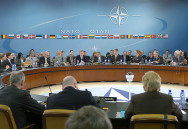Bundesregierung
NATO |
||
|
The North Atlantic Treaty
Organization (NATO) is the world's largest security policy
alliance. Originally conceived as an alliance for collective
defence in the event of an attack on member states, its
significance has since undergone considerable change.
The alliance sees itself as a
community of values held in common by free democratic states. The
Preamble of the North Atlantic Treaty describes the nature and
purpose of the alliance as follows:
"The Parties to this Treaty reaffirm their faith in the purposes and principles of the Charter of the United Nations and their desire to live in peace with all peoples and all governments. They are determined to safeguard the freedom, common heritage and civilisation of their peoples, founded on the principles of democracy, individual liberty and the rule of law. They seek to promote stability and well-being in the North Atlantic area. They are resolved to unite their efforts for collective defence and for the preservation of peace and security. They therefore agree to this North Atlantic Treaty." How was NATO created?The North Atlantic Pact was established on April 4, 1949 in Washington, D.C.. Due to the tensions between the victorious powers, the world was split into two blocs. At the time the western states saw the Soviet Union (USSR) as a military threat. Ten western European states – the UK, France, the Netherlands, Belgium, Italy, Denmark, Luxembourg, Norway, Iceland and Portugal – as well as the USA and Canada, joined forces to form a defensive alliance. Greece and Turkey joined NATO as early as 1952, and Spain followed in 1982. In 1955 the Paris Treaties paved the way for the Federal Republic of Germany to join the alliance. Accession guaranteed Germany's external security. Concerned that it might lose its military independence, France decided to withdraw from NATO's military structure in 1966. At the political level, though, it remained a full member state. The fall of the Berlin Wall in 1989 led to the collapse of the Soviet Union in 1991, and to the end of the Cold War. The Warsaw Pact was disbanded. In the 1990s, the security policy environment and the strategic situation in Europe changed fundamentally. Through its response to this change, NATO demonstrated tremendous adaptability. It now focused of partnerships for conflict prevention and crisis management. Since 1999, the former Warsaw Pact members Poland, the Czech Republic and Hungary have been members of the North Atlantic Alliance. The Partnership for Peace Agreement created a special opportunity for accession by the eastern states. As a result seven more states of the former Warsaw Pact – Bulgaria, Estonia, Latvia, Lithuania, Romania, the Slovak Republic and Slovenia – went on to join NATO.  Photo:
REGIERUNGonline / Bauer Photo:
REGIERUNGonline / Bauer The terrorist attacks in New York and Washington on September 11, 2001 led NATO to mobilise for the first time. Since then the alliance has been involved in the fight against international terrorism. Today more than 7,000 soldiers of the Bundeswehr are deployed on NATO missions in Afghanistan, Kosovo and the Mediterranean region. At the NATO Anniversary Summit in 2009 Albania and Croatia will be welcomed as new members. The security alliance will thus be enlarged to include 28 member states. How does NATO work?NATO is divided into a political and a military organisation. The supreme political decision-making body is the North Atlantic Council, which deals with virtually all areas of alliance policy. The so-called NATO Summit Meetings are the meetings of the North Atlantic Council attended by the Heads of State and Chiefs of Government. The last Summit Meetings took place in Bucharest in 2008 and Riga in 2006. Ministerial Meetings of Foreign and Defence Ministers are held twice a year, while the Permanent Representatives meet on a weekly basis. Two further decision-making bodies are the Defence Planning Committee and the Nuclear Planning Group. These meet at the level of Defence Ministers twice a year. NATO's supreme military body is the Military Committee. It is subordinate to the three political decision-making bodies, which it advises on issues of military policy and strategy. It is also responsible for overall management of the alliance's military tasks. The supreme bodies are served by some 340 subordinate bodies, as well as the International Staff and the International Military Staff. All resolutions adopted by the various NATO bodies must be reached on a consensual basis. NATO has only a small number of standing armed forces. These include its Response Force. This highly modern, multinational force is comprised of land, air and sea forces components. It can be deployed within a few days both within and outside NATO territory, across the whole spectrum of operations. The member states voluntarily make armed forces available to implement the approved operations. The military command structure is mandated to coordinate and carry out these operations. It is comprised of headquarters and bases located in various member states. The work of NATO is financed by the member states on the basis of an agreed cost distribution code.Links
|
||
